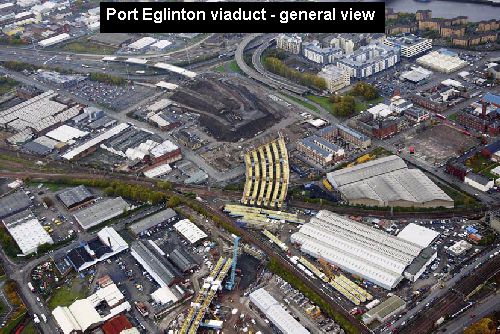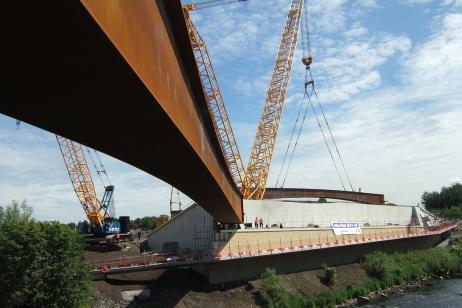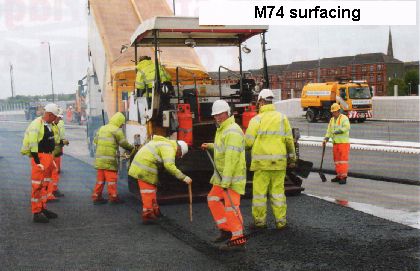
The M74 Completion project, unquestionably the most expensive motorway construction scheme in the UK, completed a vital part of the west of Scotland’s motorway network. The eight kilometres (five miles) stretch of road continued the M74 motorway from Fullarton Road Junction, near Carmyle, to the M8 motorway west of the Kingston Bridge. The motorway passes through the suburbs of Dalmarnock, Polmadie, Rutherglen, Govanhill and parts of the Gorbals near the Kingston Bridge in Glasgow on an elevated embankment with junctions at Kingston, Polmadie Road, Glasgow Road in Cambuslang and at Fullarton Road. The extension involved the demolition of the Rosebery Park football ground.
The scheme is dual three-lane with hard shoulders. Construction work on the road began in May 2008 and the new link was opened in June 2011. The construction contract was let to the Interlink M74 Joint Venture (comprising Balfour Beatty, Morgan est, Morrison Construction and Sir Robert McAlpine) in early March 2008 for a fixed price of just under £445 million, plus a £12 million allowance for possible mine workings along the route. The final construction cost was estimated to be about £490 million. The works were overseen by a partnership of Glasgow, South Lanarkshire and Renfrewshire councils together with government agency Transport Scotland, its main funder.
Before the scheme started, about £200 million had already been spent on land and advanced works. In addition, a number of businesses and factories were relocated with the assistance of an independent Business Relocation Team which worked closely with affected businesses for a number of years.
Of the three million tonnes of material which was imported to construct the M74 embankments, 580,000 tonnes of crushed concrete and demolition material from Glasgow and the surrounding area was used as embankment fill. Of that quantity, 323,000 tonnes came from the Hoover factory in Cambuslang, 30,000 tonnes from the concrete carriageway of the existing M74 near Lesmahagow, 166,000 tonnes from the demolition of flats in the Gorbals, Royston and Dalmarnock areas and 53,000 tonnes came from Paisley. In addition, 86,000 tonnes of treated chromium contaminated soil was re-used within embankments very close to where it was excavated.
As a consequence of passing through an urban area, the motorway includes 13 major structures, but some of these are particularly significant.

The Port Eglinton Viaduct is the largest structure on the scheme and carries the motorway over Eglinton Street, one of the busiest roads into the city centre, the West Coast Mainline, the Strathclyde Partnership for Transport Underground tunnels near West Street Station and the Paisley, and City & Union rail lines. It also passes through a very busy trading area where access for businesses has to be maintained and disruption kept to a minimum.
It has a main span of 138m and a total length of 750m. The two 3-lane carriageways are structurally separate and each carriageway is supported by a pair of open-top steel box girders, curved both in plan and in elevation and with a composite reinforced concrete deck slab. The two separate carriageway structures were assembled to one side of the span and then launched 170m across the railway into final position using strand jacks for movement control and rollers for support and guidance. Two computer-controlled 418-tonne capacity strand jacks were used for the operation, one to pull and one to restrain, with both strand jacks gripping a single line of strand. The first carriageway structure was launched into final position during a series of 24 two and a half hour night-time possessions of the railway line in February 2010. The second carriageway structure was launched in June 2010. Each launched carriageway structure is 200m long and weighs over 4000 tonnes. The work was subcontracted to Cleveland Bridge UK, who supplied and erected the steelwork for main contractor Interlink JV. They were responsible for designing all temporary works including the articulated roller support and guidance systems, and preparation of the engineering method statement and control data.
At the top of the picture can be seen the connections to the westbound M8 and the stub of what was originally the proposed connection from the northern section of M8 to the M74 extension. The final interchange included the construction of eastbound and westbound viaducts. Eastbound, a viaduct carries the link connecting the eastbound carriageways of the M8 and M74 over the existing M8. Westbound, a viaduct at Carnoustie Street carries the link connecting the M8's westbound carriageways to those of the M74 extension.
The largest crane in Europe, a 2000t capacity Demag PC9600, was used to install massive 90m steel beams for the Auchenshuggle Bridge, which carries the motorway over the only crossing of the River Clyde, west of the Fullarton Road junction. The 190ft crane, whose jib stretched 90 metres in the air, had taken 45 (other reports say 100!) vehicles to get it on site and a week to put it together. The beams which it placed each weighed between 250 and 330 tonnes and the longest is 86.5 metres. They were each made up of five steel box girders and assembled on site before being lifted into place.
This link connects to an excellent time-lapse sequence showing the installation of the beams on this bridge:

A time-lapse video of the new Auchenshuggle Bridge section of the M74 motorway in Glasgow
The Rutherglen Railway Station Bridge carries both carriageways of the M74 over a multitude of electrified railway lines either side of Rutherglen Station and over a section of the station platform. The four-span bridge is supported at each end by reinforced concrete supports and at three intermediate locations by reinforced concrete columns. The bridge deck (superstructure) is made up of steel box girder beams which were erected in two and a half hour rail possessions that took place during 16 consecutive nights. Reinforced concrete was cast in place over the beams.

M74 surfacingThe blacktop on the scheme, comprising some 240,000t of asphalt in the carriageways, was deemed to be beyond the reasonable capabilities of one Company on its own. It was therefore carried out as an equal joint venture of Tarmac (operating from their Cairneyhill quarry) and Aggregate Industries (at Duntilland quarry). Generally, the construction consisted of 35mm "thin" surfacing, on a 60mm binder course, on a 225mm base course, laid in two layers, which sits on 200mm of cement bound granular material.
In advance of the work starting a number of archaeological excavations took place along the route of the motorway. The M74 Dig takes advantage of the opportunities offered by the construction of the road to unearth, preserve and record some of the undiscovered history of Glasgow and its surrounding areas.
Contract details
| Section | Joint Venture |
| Fullarton Road junction to Kingston junction | Interlink M74 |